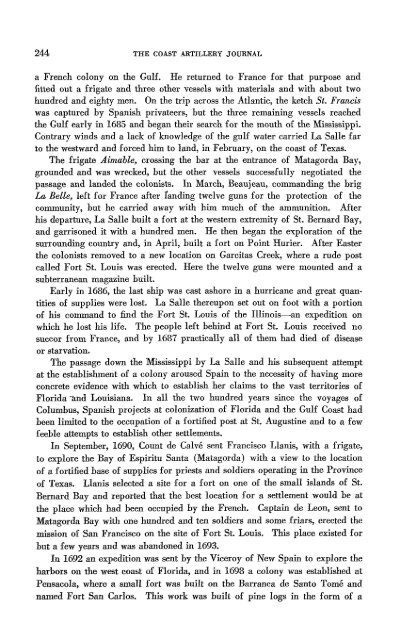THE COAST ARTILLERY JOURNAL - Air Defense Artillery
THE COAST ARTILLERY JOURNAL - Air Defense Artillery
THE COAST ARTILLERY JOURNAL - Air Defense Artillery
You also want an ePaper? Increase the reach of your titles
YUMPU automatically turns print PDFs into web optimized ePapers that Google loves.
244 <strong>THE</strong> <strong>COAST</strong> <strong>ARTILLERY</strong> <strong>JOURNAL</strong><br />
a French colony on the Gulf. He returned to France for that purpose and<br />
fitted out a frigate and three other vessels with materials and with about two<br />
hundred and eighty men. On the trip across the Atlantic, the ketch St. Francis<br />
was captured by Spanish privateers, but the three remaining vessels reached<br />
the Gulf early in 1685 and began their search for the mouth of the Mississippi.<br />
Contrary winds and a lack of knowledge of the gulf water carried La Salle far<br />
to the westward and forced him to land, in February, on the coast of Texas.<br />
The frigate Aimable, crossing the bar at the entrance of Matagorda Bay,<br />
grounded and was wrecked, but the other vessels successfully negotiated the<br />
passage and landed the colonists. In March, Beaujeau, commanding the brig<br />
La Belle, left for France after tanding twelve guns for the protection of the<br />
community, but he carried away with him much of the ammunition. After<br />
his departure, La Salle built a fort at the western extremity of St. Bernard Bay,<br />
and garrisoned it with a hundred men. He then began the exploration of the<br />
surrounding country and, in April, built a fort on Point Hurier. After Easter<br />
the colonists removed to a new location on Garcitas Creek, where a rude post<br />
called Fort St. Louis was erected. Here the twelve guns were mounted and a<br />
subterranean magazine built.<br />
Early in 1686, the last ship was cast ashore in a hurricane and great quantities<br />
of supplies were lost. La Salle thereupon set out on foot with a portion<br />
of his command to find the Fort St. Louis of the Illinois-an expedition on<br />
which he lost his life. The people left behind at Fort St. Louis received no<br />
succor from France, and by 1687 practically all of them had died of disease<br />
or starvation.<br />
The passage down the Mississippi by La Salle and his subsequent attempt<br />
at the establishment of a colony aroused Spain to the necessity of having more<br />
concrete evidence with which to establish her claims to the vast territories of<br />
Florida -and Louisiana. In all the two hundred years since the voyages of<br />
Columbus, Spanish projects at colonization of Florida and the Gulf Coast had<br />
been limited to the occupation of a fortified post at St. Augustine and to a few<br />
feeble attempts to establish other settlements.<br />
In September, 1690, Count de Calve sent Francisco Llanis, with a frigate,<br />
to explore the Bay of Espiritu Santa (Matagorda) with a view to the location<br />
of a fortified base of supplies for priests and soldiers operating in the Province<br />
of Texas. Llanis selected a site for a fort on one of the small islands of St.<br />
Bernard Bay and reported that the best location for a settlement would be at<br />
the place which had been occupied by the French. Captain de Leon, sent to<br />
Matagorda Bay with one hundred and ten soldiers and some fri~rs, erected the<br />
mission of San Francisco on the site of Fort St. Louis. This place existed for<br />
but a few years and was abandoned in 1693.<br />
In 1692 an expedition was sent by the Viceroy of New Spain to explore the<br />
harbOTson the west coa&tof Florida, and in 1698 a colony was established at<br />
Pensacola, where a small fort was built on the Barranca de Santo Tome and<br />
named Fort San Carlos. This work was built of pine logs in the form of a
















